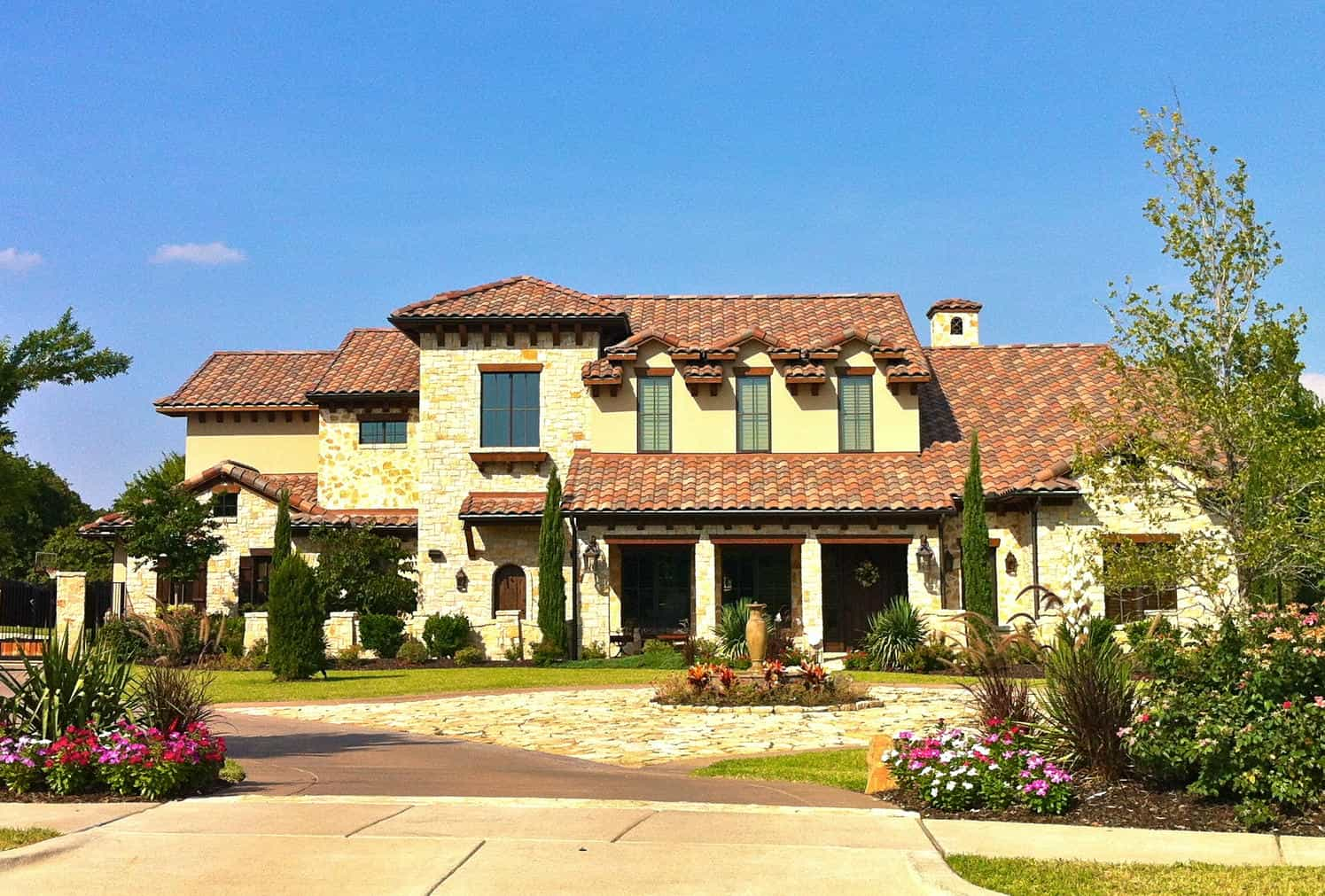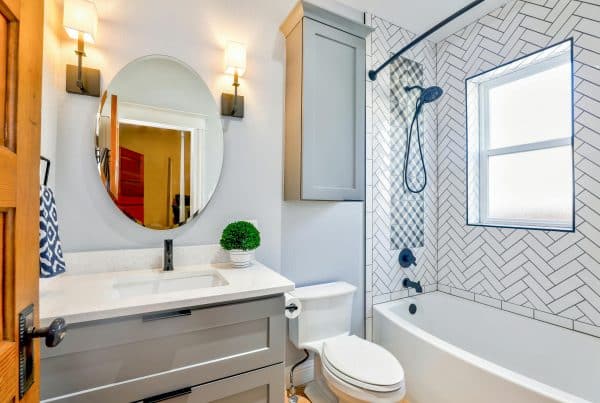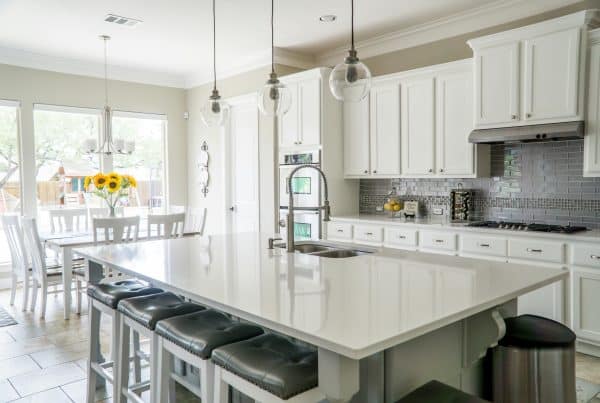Mediterranean style homes have a rich history dating back to the 1920s, when they first gained popularity in the United States. Prior to this, they evolved from older European styles, including Spanish Colonial, Italian Renaissance, and Mission Revival.
Today, Mediterranean style homes represent a blend of influences from Southern Europe’s coastal regions. They remain popular in the United States in large part due to their adaptability to modern lifestyles.
To learn more about Mediterranean style homes, keep reading our list of 9 interesting facts. For those looking for Mediterranean-inspired homes in the greater Las Vegas area, check out our Properties Search Tool.
What Is A Mediterranean Style Home?
A Mediterranean style home is one that captures the essence of Southern European coastal living.
Nowadays, in newer constructions, Mediterranean style homes are sometimes referred to as Spanish Modern or Neo-Mediterranean homes. Older constructions, meanwhile, are sometimes referred to as Spanish Colonial, Mission Revival, or Italian Renaissance homes.
These are all used to describe variations within the broader Mediterranean home style.
Mediterranean home style variations include:
- Italian Renaissance
- Spanish Revival
- Spanish Colonial
- Spanish Colonial Revival
- Spanish Modern
- Spanish Style
- Spanish Eclectic
- Modern Mediterranean
- Neo-Mediterranean
- Mission Revival
- Mediterranean Revival
- Italian Mediterranean
- French Mediterranean
- Greek Mediterranean
- Spanish Mediterranean
- California Mediterranean
- Florida Mediterranean
- Mediterranean Eclectic
- Tuscan
- Moroccan
What Is A Villa?
A villa is a type of residential house with a history dating back to ancient Rome. Villas originally served as countryside homes for upper-class Roman citizens.
Fast-forward to the present day, and the term “villa” has a much more varied meaning. Modern villas might still refer to upscale countryside estates, but they can also refer to more cost-friendly single-family residences.
A good example is in Sweden, where the term is used for single-family detached homes regardless of their size or standard.
It’s worth noting that the term “villa” is used rather liberally in the United States. Real estate developers often apply it to properties that don’t strictly match traditional definitions, such as attached homes, condominiums, and apartment units. This is done to capitalize on the term’s luxurious connotations.
Mediterranean Style Homes Vs Mediterranean Villas. What’s The Difference?
While both Mediterranean style homes and Mediterranean villas draw inspiration from Southern European coastal architecture, they do have distinct characteristics.
Mediterranean Style Homes:
- Originated in the U.S. in the 1920s as an interpretation of Mediterranean architecture
- Typically smaller in scale, ranging from modest to larger residences
- Designed primarily as permanent family homes
- Features include red-tiled roofs, stucco exteriors, and arched doorways
- Often one to two stories with symmetrical exteriors
- Popular in warm, sunny U.S. climates like Nevada
Mediterranean Villas:
- Originally designed as upscale country retreats for the wealthy
- Generally larger and more luxurious than Mediterranean style homes
- Often feature elaborate architectural elements, large grounds, and high-end amenities
- Typically multi-story with spacious, open floor plans and grand entrances
- Traditionally found in Mediterranean countries but now used for luxe homes worldwide
In summary: Mediterranean style homes adapt Mediterranean elements to American tastes, while villas are more deeply rooted in Mediterranean culture and lifestyle. However, in modern real estate, these distinctions sometimes blur.
Want To See Examples of Mediterranean Style Homes? Check Out The Video!
9 Facts About Mediterranean Style Homes
1. Mediterranean Style Homes Are Designed To Be Naturally Cool
Did you know that Mediterranean style homes are built to cool naturally? Thanks to their thick stucco walls, which are usually painted in light shades to bounce sunlight away, they’re excellent insulators.
Moreover, Mediterranean style homes use high ceilings that allow hot air to drift up and away from main living areas. Furthermore, large, strategically placed windows allow homeowners to create refreshing cross-breezes in the summer.
Compared to typical suburban tract homes, Mediterranean style homes are a touch more energy-efficient.
2. Arches in Mediterranean Style Homes May Boost Mood
Mediterranean style homes are characterized by arched windows and doorways, which, interestingly enough, may have positive psychological effects.
A study from 2013 showed that people tend to judge spaces with curved features as more beautiful than those with angular shapes. Moreover, when people judged the curved spaces to be beautiful, it activated a brain region associated with emotion and reward.
Want to dive deeper into the science behind this? Check out the study here: Impact of contour on aesthetic judgments and approach-avoidance decisions in architecture.
3. Mediterranean Style Homes Emphasize Indoor-Outdoor Living
While there are certainly exceptions to the indoor-outdoor rule, the Mediterranean home style originated from sunny regions where people wanted to spend time “outdoors” while enjoying the comfort of their homes. The style is fundamentally built on this principle.
When Mediterranean style homes became popular in the United States, they adopted the features that best accommodated an open-air lifestyle, such as open floor plans, large windows, and French doors.
Additionally, outdoor areas—patios, verandas, terraces, and courtyards—serve as natural extensions of the living space.
Modern and High-End Mediterranean Style Homes:
Today, Mediterranean style homes are fantastic for relaxation, dining, and entertainment, and they’re also exceptional for family use.
To be fair, there is a lot of mixing and matching with current trending design styles. Modern Mediterranean style homes, for instance, may include sliding glass doors, retractable walls, and steel components.
High-end Mediterranean style homes may feature rooftop infinity pools and hot tubs, which obviously aren’t classic features that people used hundreds of years ago. This is another way to blend the old with the new.
4. Clay Tile Roofs on Mediterranean Style Homes Can Last Over 100 Years
Mediterranean style homes are often recognizable by their clay tile roofs. You’ve probably seen a house with a red clay roof, and perhaps it stood out to you.
They certainly have an aesthetic appeal, but they offer more than just looks. It’s well known that clay roof tiles are very durable. In fact, they can last up to 100 years with proper installation, and some have lasted even longer.
Their exceptional longevity is due to clay’s natural resistance to various ills. Rot, insects, fire, and extreme weather conditions.
Granted, clay tile roofs are more expensive than shingle roofs, but their longevity makes them particularly attractive, and many Mediterranean style homes have them.
5. Mediterranean Revival Was First Used in Upscale Resorts
Mediterranean Revival homes are a beautiful Southern European sub-genre that became popular in the United States around the turn of the 20th century.
They were first used in upscale hotels and seaside resorts, but they transformed as the 1920s and 30s unfolded. Soon, private owners wanted single-family residences in this coveted style, particularly because of their breezy, open layouts, which proved well-suited for warm, sunny climates.
Today, Mediterranean Revival homes are a sought-after choice in upscale neighborhoods across the country, including Las Vegas.
6. Mediterranean Style Houses Sometimes Have Secret Gardens
When you step into a Mediterranean style home, you might find a surprise; some of them have hidden or semi-private gardens.
These secluded spaces are usually cleverly integrated into the home’s layout as a nod to traditional Mediterranean courtyards. In contemporary Mediterranean-inspired homes, hidden gardens take various forms, from interior courtyards to rooftop retreats to secluded nooks.
Curiously, the term hidden garden is somewhat of a misnomer since they’re usually visible from certain parts of the house.
7. Many Mediterranean Homes Are Restored to Blend Original Integrity with Modern Amenities
Restoring old Mediterranean homes is a challenge, and it can be expensive. But if you’re looking for a truly authentic Mediterranean home for modern use, it’s well worth it.
The difficulty comes in when you preserve their distinct features, such as red-tiled roofs, stucco exteriors, and all the ornate details….And you have to do this while incorporating modern amenities. This requires a delicate balance from an experienced remodeler.
To avoid damaging the home, restoration experts use minimally invasive techniques. Additionally, to preserve the integrity of the original design, they reinforce original structures and refinish woodwork through a variety of methods, including epoxy resins and specialized wood fillers. In warm climates, they use materials that withstand sun damage while maintaining the original, traditional look.
The goal is to maintain the home’s beauty and original intent while updating it for modern use. This often requires collaboration between architects, specialized craftsmen, and of course, homeowners.
8. Mediterranean Style Homes May Feature Exquisite Tilework Inspired by Historic Traditions
If you’ve ever been inside a Mediterranean style home, you’ve probably seen a decorative mosaic or a series of tilework. Both of these features are deeply rooted in Mediterranean cultures.
Mediterranean tiles come in a variety of styles, including Italian Majolica, Spanish Azulejo, and Portuguese Azulejo. Each style has its own unique flair, and you often see blue, white, and earthy tones accompanying such tiles.
While traditional Mediterranean tiles are often ceramic or terracotta, modern interpretations use porcelain. These are versatile in their applications, gracing floors, walls, kitchen backsplashes, bathroom surfaces, and even swimming pools.
In contemporary Mediterranean style homes, you might find updated tile designs that incorporate modern aesthetics.
9. Mediterranean Style Homes Often Feature Central Courtyards
Central courtyards are a defining feature of Mediterranean style homes. They’re what homeowners often visualize when they think of this style.
The inclusion of courtyards in Mediterranean homes varies across subtypes, such as Spanish Colonial, which often incorporate large entrances or inner courtyards with outdoor kitchens.
While not universal, courtyards frequently accompany other outdoor spaces, such as patios.
Find Homes In Las Vegas with The Real Estate Guy
Are you looking for your dream home in the Las Vegas area? If so, visit our Home page to learn more about our company and how we can help you find the perfect Mediterranean style home for your needs.
» MORE: 9 Facts About Hacienda Style Homes + Hacienda vs Spanish Homes
» MORE: 9 Facts About Victorian Style Homes + Victorian vs Edwardian Homes
» MORE: Spanish vs Mediterranean House: 5 Differences + Similarities
Featured Image Source: Mediterranean house in Southlake
Photographer: NETarrantMan
Source: Wikimedia Commons
License: CC BY-SA 3.0
Copyright © 2012 NETarrantMan
This work is licensed under the Creative Commons Attribution-Share Alike 3.0 Unported license. To view a copy of this license, visit the link above. This image was cropped, resized, and compressed. Disclaimer: The use of this image does not imply endorsement by the photographer or Wikimedia Commons. The image is used solely for illustrative purposes in the context of discussing Mediterranean style homes.






